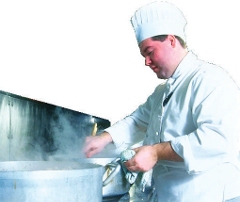

| Topic: Heat Stress Can Kill | |
| Date Issued: August 25, 2014 | Date Revised: |
IT'S THE LAW!
Hot summer weather can cause dangerous conditions for people who work in places such as bakeries, foundries, restaurant kitchens, laundries and pulp mills. A combination of high outdoor temperatures with heat build-up inside can be fatal. The following is a reminder for workers and employers of the regulations relevant to heat stress. These regulations are part of the Occupational Health and Safety (OHS) Act’s General Regulation (Reg.) 91-191.
Under paragraphs 9(2)(b)(c.1)(d) of the OHS Act, employers must:
On a worksite where heat stress is possible, employers must:
While employers have responsibilities, so do employees. Under section 12 of the OHS Act, employees must:
You owe it to yourself and your co-workers to recognize the signs of heat stress and to know the proper first aid measures. Everyone should learn to take a few simple precautions to prevent heat cramps, heat exhaustion and heat stroke from happening in the first place.

Drink plenty of fluids
When working in hot conditions, your body can lose up to one litre of fluid per hour. Don’t rely on thirst to tell you when or how much to drink. Drink large quantities of fluids before you begin to work and about one cup every 20 minutes while you work. The best fluid to drink is water, or liquids with some sodium content. Don’t drink any form of alcohol – it causes your body to lose fluids.
Increase your salt intake slightly
The salt in most prepared foods should be sufficient, but if you’re working in extreme conditions, drink liquids with some sodium content, or try an electrolyte replacement drink.
Wear appropriate clothing
Wear light-coloured, loose-fitting clothing that doesn’t leave too much skin exposed. Wear a hat in the sun.
Take it slowly
Start by working slowly and taking short, frequent breaks. Gradually increase the frequency, intensity, or duration of your tasks as your comfort level improves. Some workers reach full acclimatization within a week. Others take longer, depending on their size, stamina, and the type of work they’re doing.
Listen to your body
Learn to recognize the three main forms of heat stress and their symptoms: